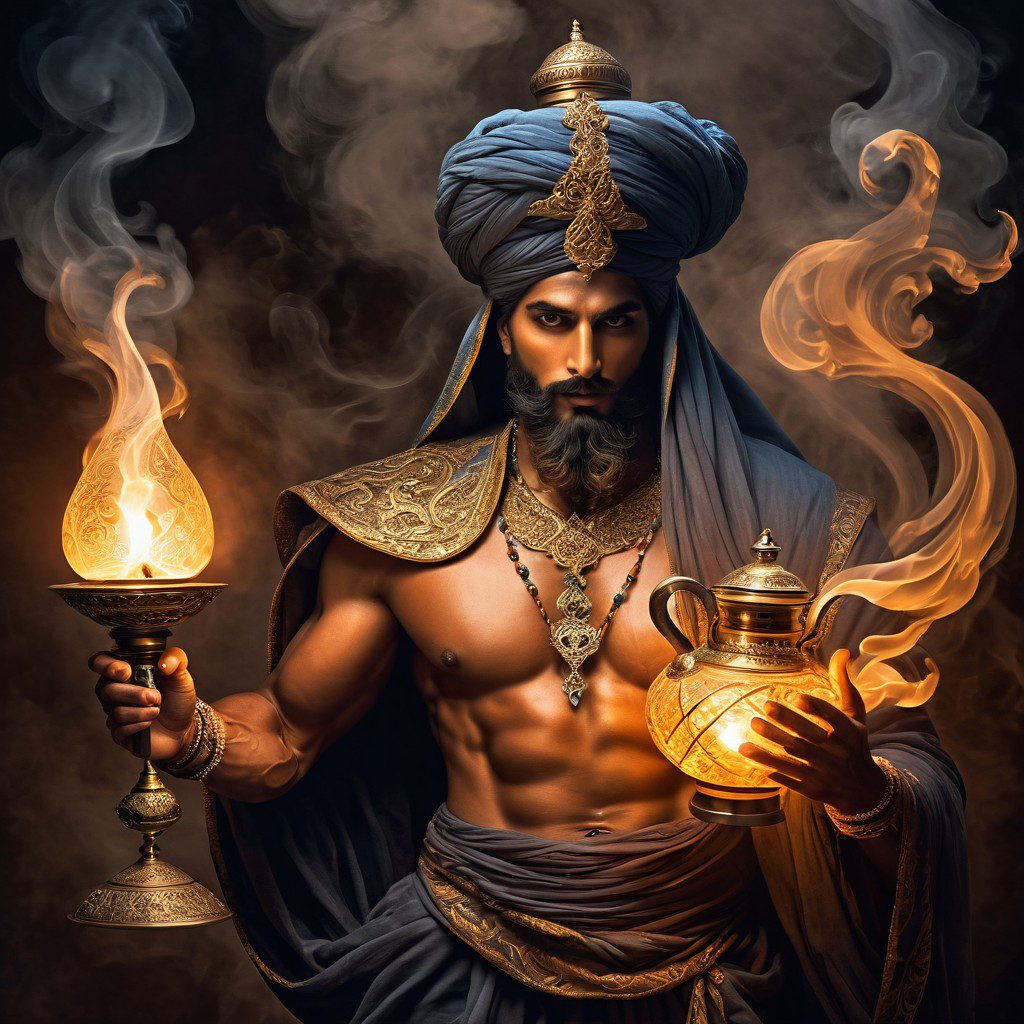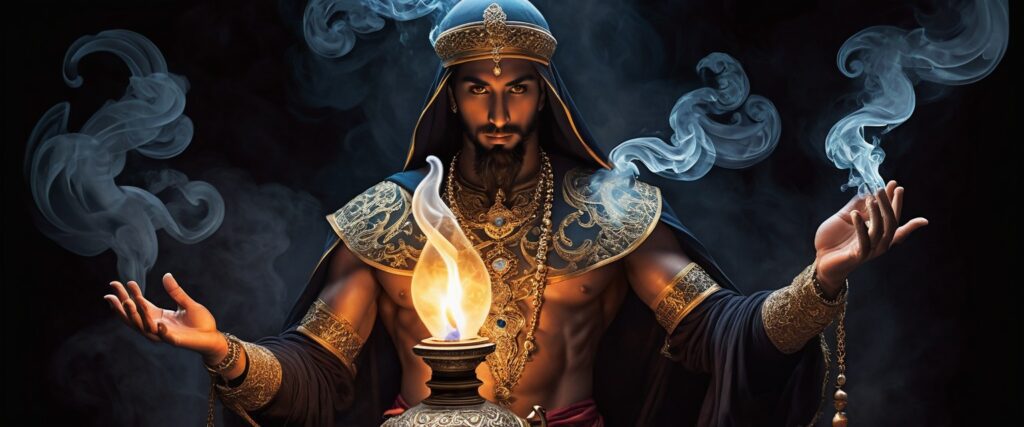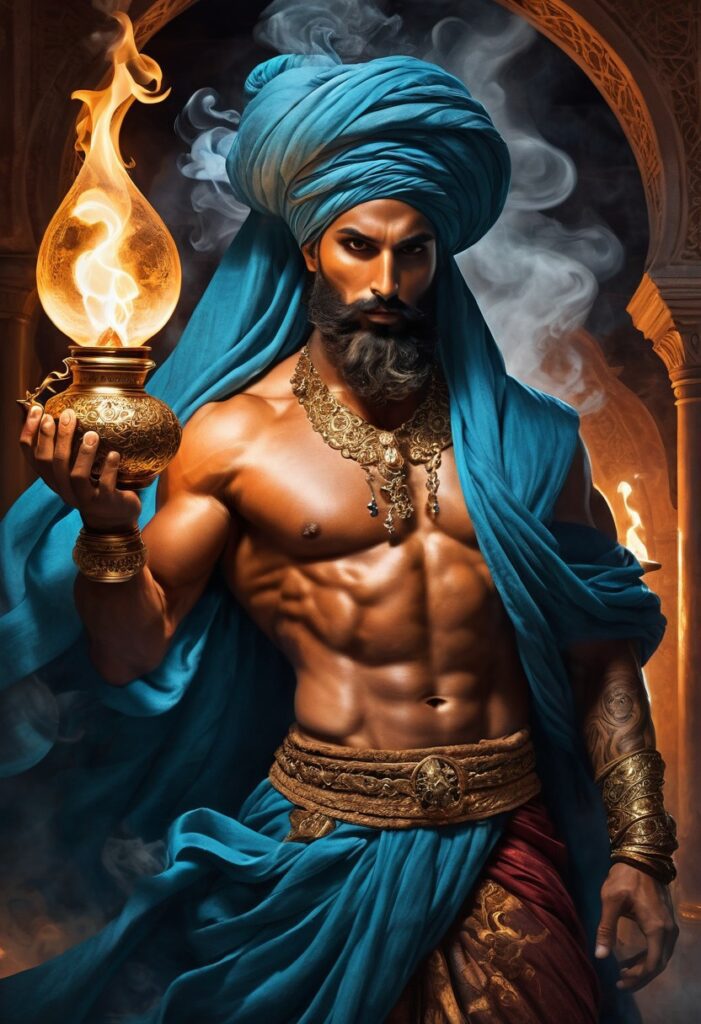Djinn: The Mystical Beings of Fire from Arabian and Islamic Folklore

n the swirling sands of the Arabian desert and the dimly lit corners of ancient cities, mysterious spirits known as Djinn have long captivated the imagination. These supernatural beings, made from smokeless fire, are central to Arabian and Islamic folklore, where they exist alongside humans, invisible yet powerful. Neither fully benevolent nor purely evil, Djinn possess free will and immense abilities, making them some of the most complex and enigmatic creatures in global mythology.
The Origin and Nature of the Djinn
According to Islamic tradition, Djinn were created by Allah from smokeless fire, preceding the creation of humanity. Unlike angels, who are beings of pure light and have no free will, Djinn have the ability to choose between good and evil, much like humans. This duality is key to understanding their place in folklore: they can be benevolent and helpful or malevolent and destructive.
The Djinn’s existence runs parallel to that of humans. They live in their own societies, with governments, marketplaces, and families, but their world is hidden from human sight. They are capable of influencing the human realm by taking on physical forms, communicating with people, and even possessing individuals. However, their powers also make them difficult to control and unpredictable.
In Islamic theology, Djinn are frequently mentioned in the Quran, where they are described as one of three sentient creations, along with humans and angels. The most famous Djinn in Islamic tradition is Iblis, who refused to bow to Adam and was cast out of heaven, becoming synonymous with Satan.
Types of Djinn
The Djinn are a diverse group, with different types possessing different abilities and temperaments. Some common types include:
- Marid: These Djinn are often depicted as the most powerful, with immense physical strength and magical ability. They are commonly associated with water and are known for their arrogance and pride. In many stories, the Marid are the Djinn most often associated with granting wishes, though typically at a great cost.
- Ifrit: The Ifrit are fiery, malevolent Djinn known for their wrath and destructive power. Often depicted as rebellious and dangerous, Ifrit dwell in ruins and isolated places. In the Thousand and One Nights, Ifrit frequently appear as antagonists who can be outwitted by clever heroes.
- Shaitan: Closely linked to the Arabic word for “Satan,” Shaitan are evil Djinn that serve no one but themselves. They are known to lead humans astray, whispering temptations and spreading discord.
- Ghul: The Ghul (or Ghoul) is a type of Djinn associated with graveyards and desert wastelands. Ghouls are shape-shifters that often take the form of animals to lure humans into traps. In folklore, they are notorious for devouring the flesh of the dead and living.
- Jann: Considered the weakest of the Djinn, the Jann are more closely aligned with nature. They are said to be nomadic, often wandering the desert and interacting with humans in a more neutral manner. Jann can also be benevolent and sometimes offer assistance to humans.
The Djinn in Mythology and Folklore
Djinn are central to many stories within the Arabian Nights, a collection of Middle Eastern folktales that have been retold for centuries. In these stories, Djinn are often shown as powerful entities capable of granting wishes, but these interactions are rarely straightforward or without consequences.
One of the most famous Djinn stories from the Arabian Nights is that of Aladdin. In this tale, a young man named Aladdin discovers a magical lamp containing a Djinn, or Genie, who can grant him three wishes. Though popularized by Western retellings, such as Disney’s Aladdin, the original story shows a more complex relationship between the Djinn and its master. Unlike the charming, friendly Genie of modern adaptations, the Djinn in the original tale is powerful, sometimes threatening, and not easily controlled.
Another well-known tale is The Fisherman and the Djinn, in which a poor fisherman discovers a brass jar in the sea, containing a Djinn who was imprisoned for centuries. Furious at his captivity, the Djinn swears to kill the man who frees him, but the clever fisherman tricks the Djinn back into the jar, saving his life and teaching a lesson about hubris and wisdom.
Djinn in Islamic Tradition

While Djinn are present in folklore, they also play a significant role in Islamic theology. The Quran describes Djinn as beings created by Allah to worship Him, just as humans were. However, their free will allows them to choose their paths, leading some to righteousness and others to rebellion.
Islamic texts warn against interacting with Djinn, as many are considered deceitful and dangerous. Some Djinn are said to possess humans, causing physical or psychological harm, and Islamic exorcism rituals, known as ruqya, are performed to drive them out. Reciting verses from the Quran, particularly Surah Al-Jinn, is believed to protect against malevolent Djinn.
Despite their often negative portrayal, not all Djinn are evil. In fact, some Djinn have converted to Islam and live in harmony with humans. However, the idea that Djinn can influence human behavior, tempt people away from faith, and cause physical harm has kept them in a space of fear and reverence in many Islamic cultures.
Djinn in Modern Culture
The Djinn has transcended its traditional boundaries and entered modern culture in various forms. Films, television shows, and books frequently draw on the rich mythology of the Djinn to create complex characters and narratives. In Western culture, the Djinn is often conflated with the Genie, though the two are not always the same in traditional lore.
In Neil Gaiman’s American Gods, the Djinn appear as enigmatic beings, blending into human society while maintaining their supernatural abilities. The 2013 horror film Djinn explores the darker side of these creatures, portraying them as malevolent entities that haunt and torment.

Djinn also appear in video games such as the Final Fantasy series and The Witcher, where they are depicted as powerful, wish-granting spirits, often with their own hidden agendas. The Djinn’s portrayal in modern media continues to evolve, reflecting both the fear and fascination that has surrounded these beings for centuries.
Strengths and Weaknesses of the Djinn
Strengths:
- Immense Power: Djinn possess extraordinary magical abilities, including shape-shifting, invisibility, and control over the elements. Their mastery of magic often makes them nearly unstoppable.
- Free Will: Unlike angels, Djinn have free will and the ability to make choices, giving them the potential for great wisdom or great destruction.
- Immortality: Djinn are not bound by the same rules of mortality as humans. Though they can be killed, they live far longer than humans and can recover from injuries that would be fatal to mortals.
Weaknesses:
- Susceptibility to Control: Despite their immense power, Djinn can be bound or trapped by magical objects, such as bottles, lamps, or talismans. They are often forced into servitude when captured by humans.
- Divine Weakness: Islamic exorcism rituals and the recitation of Quranic verses are said to weaken or banish Djinn, especially malevolent ones. Djinn are also believed to be fearful of iron.
- Pride and Hubris: Many Djinn, especially Marid and Ifrit, are proud and arrogant, which often leads to their downfall when dealing with clever humans.
Djinn: The Mystical Bridge Between Worlds
Djinn are among the most complex and fascinating beings in folklore and religious tradition. They embody the tension between good and evil, power and control, and the visible and invisible worlds. With their origins rooted in ancient Middle Eastern traditions and their stories still thriving in modern culture, Djinn remain mysterious, powerful figures that straddle the line between myth and reality.
Whether benevolent or dangerous, these spirits serve as a reminder of the unseen forces that might shape our world, the choices we make, and the consequences they bring. In their stories, we find cautionary tales about power, freedom, and the often unpredictable nature of the supernatural.
